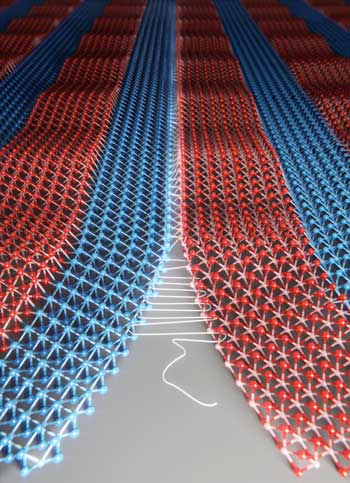| Posted: Mar 08, 2018 |
Researchers sew atomic lattices seamlessly together
(Nanowerk News) Joining different kinds of materials can lead to all kinds of breakthroughs. It's an essential skill that allowed humans to make everything from skyscrapers (by reinforcing concrete with steel) to solar cells (by layering materials to herd along electrons).
|
|
In electronics, joining different materials produces heterojunctions-the most fundamental components in solar cells, LEDs or computer chips. The smoother the seam between two materials, the more easily electrons flow across it; essential for how well the electronic devices function. But they're made up of crystals-rigid lattices of atoms, which may have very different spacing-and they don't take kindly to being mashed together.
|
|
In a study published in Science ("Coherent, atomically-thin transition-metal dichalcogenide superlattices with engineered strain"), scientists with the University of Chicago and Cornell revealed a technique to "sew" two patches of crystals seamlessly together at the atomic level to create atomically-thin fabrics.
|
 |
| Scientists with the University of Chicago revealed a technique to 'sew' two patches of crystals seamlessly together at the atomic level to create atomically-thin fabrics. (Image: Park et al)
|
|
The team wanted to do this by stitching different fabric-like, three-atom-thick crystals. "Usually these are grown in stages under very different conditions; grow one material first, stop the growth, change the condition, and start it again to grow another material," said Jiwoong Park, professor of chemistry in the James Franck Institute and the Institute for Molecular Engineering and a lead author on the study.
|
|
Instead, they developed a new process to find the perfect window that would work for both materials in a constant environment, so they could grow the entire crystal in a single session.
|
|
The resulting single-layer materials are the most perfectly aligned ever grown, Park said. The gentler transition meant that at the points where the two lattices meet, one lattice stretches or grows to meet the other-instead of leaving holes or other defects.
|
|
The atomic seams are so tight, in fact, that when they looked up close using scanning electron microscopes, they saw that the larger of the two materials puckers a little around the joint.
|
|
They decided to test its performance in one of the most widely used electronic devices: a diode. Two different kinds of material are joined, and electrons are supposed to be able to flow one way through the "fabric," but not the other.
|
|
The diode lit up. "It was exciting to see these three-atom-thick LEDs glowing. We saw excellent performance-the best known for these types of materials," said Saien Xie, a graduate student and first author on the paper.
|
|
The discovery opens up some interesting ideas for electronics. Devices like LEDs are currently stacked in layers-3D versus 2D, and are usually on a rigid surface. But Park said the new technique could open up new configurations, like flexible LEDs or atoms-thick 2D circuits that work both horizontally and laterally.
|
|
He also noted that the stretching and compressing changed the optical properties-the color-of the crystals due to the quantum mechanical effects. This suggests potential for light sensors and LEDs that could be tuned to different colors, for example, or strain-sensing fabrics that change color as they're stretched.
|
|
"This is so unknown that we don't even know all the possibilities it holds yet," Park said. "Even two years ago it would have been unimaginable."
|

